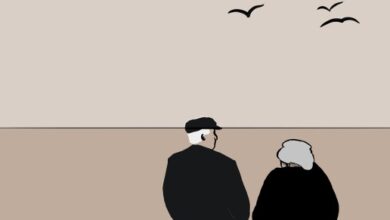
There Will Come Soft Rains, published in 1950 by Ray Bradbury, is a short story that depicts the struggle of nature versus technology. This futuristic story by Ray Bradbury demonstrates how far we’ve come as humans, thanks to the power of technology. It also hints at how far we’re yet to go as a civilization.
There Will Come Soft Rains | Summary
The story starts at seven in the morning, with an alarm clock singing into an empty house. A brief description of the kitchen- where the cooking seems to be happening by itself- shows that this is a futuristic setting. The automated voice from the kitchen ceiling announces that it is the 4th of August in the year 2026, and proceeds to list out important occasions of the date. It then continues to set forth a to-do list, involving what time its inhabitants should be leaving for school and work. However, there is not a single noise. The eggs set for breakfast eventually shrivel, the food untouched, and the futuristic machinery of the house disposes of it automatically. It is raining outside, and the weather box softly sings a tune in relation to dissipating it.
At nine-fifteen, the house intoned that it is time to clean, and the entire process is taken care of by tiny, robotic mice. By ten, the sun is shining again, and the house is shown to be standing alone in the midst of rubble- the only house that survived a nuclear bombing, though its inhabitants don’t seem to have made it out alive. The house had been destroyed and burnt- the only spots that remain are five silhouettes- the parents, the two children and a ball. The house is vigilant- it constantly asks the password even if an animal nears its boundary, and shuts down immediately if something gets too close.
At noon, the family’s dog lets out a whine, and the house recognizes its voice and allows it to enter. The dog is worn thin, and one entering the house, realises that the family is no longer there. The house begins cooking pancakes, and the smell sends the dog into a frenzy, eventually dying from the exhaustion. The house continues living as though it is full- pulling out tables and cards and martinis, setting up the nursery full of colourful toys during the kids’ hour, filling the bathtub and setting the table for dinner. At night, the house asks Mrs. McClellan what poem she wants to hear, and in the silence, chooses one of its own and starts reciting it- Sarah Teasdale.
At ten o’clock in the night, the house begins to die from a fire. It is unable to save itself, as the fire reaches the attic and causes an explosion. It crumbles away among the other ruins until only one wall is left. It is the next day, and we know this because despite the destruction, the automated voice keeps repeating the date: “Today is August 5th, 2026.”
There Will Come Soft Rains | Analysis
Ray Bradbury was very well known for his humanism-centric work, as well as stories detailing futuristic elements and societal development. There Will Come Soft Rains is a perfect example of this- set in the year 2026, it depicts a scenario where the family living in the house had been killed from a nuclear explosion, yet the robotic house lives on and continues functioning as though it was fully occupied on a normal day. The eeriness of the house’s self-sufficiency is displayed in its capable yet emotionless actions. Further, the house can do almost anything which a human can- if not more- which hints at the robots on the verge of overpowering humankind. The themes in this story are futurism, time, power of technology, nature versus robots, and death. Bradbury uses a great deal of metaphors and imagery which paint a sinister picture of the lone robotic house, standing tall among the rubble caused by nuclear warfare.
The story commences with a clock, immediately referencing the importance of time in the story. It chimes, “Tick-tock, seven o’clock, time to get up, time to get up, seven o ‘clock!” and then “Seven-nine, breakfast time, seven-nine!” It continues with “Today is August 4, 2026,” and then gives reminders about birthdays, anniversaries and special occasions. From this, we can see that it seems to be doing the job of a person- giving reminders of daily tasks, and overall reducing the work of humans. It depicts the overarching reign of technology. Further, the kitchen utensils are preparing breakfast by themselves, yet another implication of the power the machinery has over the human. The family is not required at all but to simply exist, and the house takes care of everything for them. It is important to note that the more dependent humans become on robots, the more powerful a robot can become, as the human slowly becomes less capable. This links with the theme of death, as well- not literal death, but the death of human capacity.
The alarm sings “Rain, rain, go away; umbrellas, raincoats for today. ..” indicating the weather. Rain is often symbolic of melancholy and rebirth. This is interesting, because the story displays the house’s last functioning day, a day without the family that usually resides there. This can create a melancholic environment. Further, the death of the family and then the destruction of the house itself gives way for a new, unknown beginning- rebirth, of sorts. The lack of response from the family indicates their absence. There is a chill created by the way the house continues functioning as though the absence of human beings in it means nothing at all. This falls under the broader theme of robots versus nature- it is nature’s course which has taken the family’s life, and the robotic house seems to have out-lived that, at least for the moment.
The “radioactive glow” is what symbolizes the nuclear explosion. The description of the family’s silhouettes- especially the children playing with the ball- gives a vivid image of the fleeting nature of life. It shows how they were living as usual one moment, and wiped out the next. Further, these silhouettes are simply preserved amongst the wreckage, and the house has no clue that there are no inhabitants. This hints that no matter how powerful a robot is, there is a certain level of emotionality that it cannot reach- and this, from a personal perspective, is what makes it all the more dangerous. Greater and more technical capability without the element of sentiment or a guilty conscience is a perilous combination. However, the “wall, tiny robot mice” used to clean the house seem to be an attempt to liken the robot to a living being by using animal robotic structures.
The line from There Will Come Soft Rains given below is a great example of the nature versus technology theme:
“… on getting no answer from lonely foxes and whining cats, it had shut up its windows and drawn shades in an old-maidenly preoccupation with self-protection which bordered on a mechanical paranoia.”
The animals which come closer to the house depict nature, and the house’s refusal to let them in- as well as its self-protection- show the house’s constant attempt to overpower it. In the end, it only allows the dog inside after recognizing its voice- this symbolizes the all-knowing nature of technology. It is able to recognize the house’s dog down to its sound, which represents its ability to store and use information. It is interesting that Bradbury uses the term “mechanical paranoia” as it acts in contrast to the paranoia machines may instill in humans.
The robot mice express irritation at having to clean up after the dog, rather than any form of sympathy or affection- once again highlighting the lack of emotions in a machine. Next, we are introduced to the inhumanity of technology in a different way- “the stove was making pancakes which filled the house with a rich baked odour and the scent of maple syrup. The dog frothed at the mouth, lying at the door, sniffing, its eyes turned to fire. It ran wildly in circles, biting at its tail, spun in a frenzy, and died.” We are unable to learn whether the house did this on purpose, but it showcases the cruelty that machines possess as an ordinary standard- it is the scent of the pancakes that threw the dog into a frenzy. At this point, it is past morning- we may wonder why the house is making pancakes at such an hour.
The death of the dog represents the death of the last family member of the house, and the last living being with a range of emotions. The robot mice clean up the body:
“Delicately sensing decay at last, the regiments of mice hummed out as softly as blown gray leaves in an electrical wind.”
It is done without an ounce of remorse. The use of the phrase “electrical wind” gives the readers a clear image of who is in charge and what is left of the house. Later into the afternoon, the house arranged a set-up of games and evening activities as it usually would have for the family- once again paying no heed that the family wasn’t there. “At four o’clock the tables folded like great butterflies back through the paneled walls.”- the reference to butterflies is the second time the machine-house resembled a living animal, the first being the mouse. It represents technology’s attempt to replicate nature. Here’s a similar example : “There was the sound like a great matted yellow hive of bees within a dark bellows, the lazy bumble of a purring lion. And there was the patter of okapi feet and the murmur of a fresh jungle rain, like other hoofs, falling upon the summer-starched grass.”
This is another reference to the livelihood that does not exist in the house. Even this description of pure life and animals are robotic features set up by the machine.
Towards the end of the story, the house starts reciting a poem of its own choice, since the mother was not there to choose. Interestingly, the poem by Sara Teasdale was one about the continuation of life in a post-apocalyptic world. However, the contrast is that Teasdale’s poem emphasizes the power of nature- nature is so great that humankind cannot lay a hand on it, and Spring will not even notice that humans have perished. This is the opposite of Bradbury’s poem, which displays a post-nuclear explosion setting where the machine has outlived the humans, and is attempting to overthrow nature, too.
In the end, it is a fire that destroys the house. This is the end of the nature versus technology theme in this story- it is nature that takes down the robotic house. It is important to note the way the house’s description is written:
“The house shuddered, oak bone on bone, its bared skeleton cringing from the heat, its wire, its nerves revealed as if a surgeon had torn the skin off to let the red veins and capillaries quiver in the scalded air. Help, help! Fire! Run, run!”-
The use of the word “capillaries”, “bone”, “skin” and “skeleton”, as well as the alarm shouting for help, equates it to a real human being, which is a point that has been anchored throughout the story- the resemblance of the machine to a human being. The humanistic elements such as cooking, cleaning, speaking, recognizing voices, it’s everyday functions.
The house does not “die” easily- the robotics put up a fight, which can be seen as a personified nature versus robot struggle. From the “robot mice” attacking, to the onslaught of “mechanical rain”, we see technology attempt to duplicate every inch of nature’s elements. The scene of the robot mice thinking they won the battle, only to be proven wrong, may be in reference to the slight arrogance of technology, and the unknown and unpredictable abilities of nature. The house continues to struggle even as it dies, the alarm continues to announce the date- “Today is August 5, 2026, today is August 5, 2026, today is…” This represents a refusal to accept defeat even after the war is over. It also marks the ending of the story with a timestamp, the same way it started. Further, this highlights the theme of an all-consuming death to a house which could supposedly do anything. This ending scene, specifically the fierce struggle between the fire (representing nature) and the house (representing technology) is a personified war which exhibits the power of nature and the failed attempts of robotics to conquer it.



